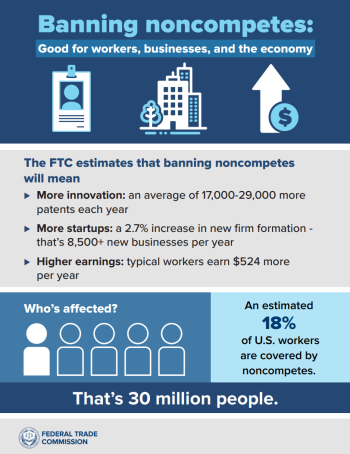Here’s what the FTC’s ban on noncompetes means for employee communications
The FTC delivered its final ruling on April 23 promising business growth, higher wages and rapid innovation.

On April 23, the Federal Trade Commission (FTC) delivered a final rule to ban noncompete agreements nationwide, a decision that it claims will allow workers to change jobs or take on additional work more freely, increase innovation and create new businesses. California passed similar legislation last year, which took effect this past January.
“Noncompete clauses keep wages low, suppress new ideas, and rob the American economy of dynamism, including from the more than 8,500 new startups that would be created a year once noncompetes are banned,” FTC Chair Lina M. Khan said in a post announcing the ban.

Credit: FTC
“In fact, more lower-wage workers are bound by noncompete clauses than high-paid workers,” noted Amanda Ponzar, Chief Marketing and Communications Officer at CHC: Creating Healthier Communities citing CBS News. “This new rule then sounds like a more equitable approach to support American workers and more opportunity.”
“Instead of a noncompete penalty, why not use retention bonuses?” she asked. “Want to keep your employees? Why not have a great workplace? Pay them well, treat them well and and provide more flexibility—which is key.”
While the U.S. Chamber of Commerce, the largest lobbying group in the country, announced plans to sue the FTC over this rule, now is still the time for communications leaders to consider how the looming decision will impact their workforce— and build an internal messaging strategy around it.
What comms can do
Under this rule, the FTC notes that “employers will be required to provide notice to workers other than senior executives who are bound by an existing noncompete that they will not be enforcing any noncompete against them.” The rule will take place 120 days after its publication in the federal register, which the FTC estimates will fall sometime in September.
This means that, whether you sit within the HR function or not, it’s time to get your legal, HR and comms in the same room to discuss how your messaging around noncompetes will unfold. Whether it exists as a strictly boilerplate obligation or a more contextualized letter from leadership that explains what this means for employees will wholly depend on the culture and expectations that your leaders have set with employees.
Buried in the oft-spoken platitude of “bringing your whole self to work” is the idea that a well-rounded employee may have other work — contracted, freelance or even full-time —that they do on the side.
This is a reality that may be hard for your leaders to swallow, but presenting them with the facts can be a sobering exercise—a 2023 study by EY (FKA Ernst and Young) found that 39% of Gen Z had both a job and a side hustle.
“Employers of Gen Z need to recognize that this is not an all-eggs-in-one-basket kind of crowd, and, ideally, appreciate the varied experience, catlike tech reflexes and time management skills many young adults now bring to the table,” the study reads.
“Gen Z’s top priority remains enjoying their work, although making money runs a close second as the cost of living keeps rising. And they’re getting more creative in their approach, using every tool in the shed as traditional, employer-driven career paths shift to individual-driven, strategic monetization of acquired skills, knowledge and experience.”
Building an employer brand and an employee value proposition that acknowledges this reality is the best way to attract the next generation of talent to our organization and position your business as an employer of choice. This can surface on your social channels and owned pages in subtle ways, say, by showcasing an employee doing something outside of work like holding their own art show or performance.
Of course, if that employee’s life beyond their scope of work is not considered internally, your workforce will call out the disconnect externally. That begs another question: How can employee comms help protect your organization’s investments and culture simultaneously?
Bridging business and culture with comms
Understanding that this rule may disrupt certain business operations and upend employee expectations, the FTC offered some recommendations for alternative approaches to non-competes.
“Trade secret laws and non-disclosure agreements (NDAs) both provide employers with well-established means to protect proprietary and other sensitive information,” the FTC wrote. “Researchers estimate that over 95% of workers with a noncompete already have an NDA.”
In a snarky call to step up, the FTC went on to say that employers who want to retain employees “can compete on the merits for the worker’s labor services by improving wages and working conditions.”
On the practical end, comms leaders should share and discuss this FTC resource page with cross-functional partners in HR and legal. The page offers steps for compliance that all teams can review and determine their role in operationalizing. It also includes an FAQ that’s readymade for the HR resource page on your intranet—and the managers who are in a prime position to answer any questions that their direct reports have.
Culture drives growth when the needs of the business are purposefully communicated with employees in mind. While this ban may remain a future worry to those outside of California for the time being, the leaders who codify and communicate a compliance strategy now will be best prepared to address the shifting expectations of their workforce in the future. Proactively putting such policies in place will ultimately strengthen the employer brand and protect the employee experience.
Justin Joffe is the editorial director and editor-in-chief at Ragan Communications.







